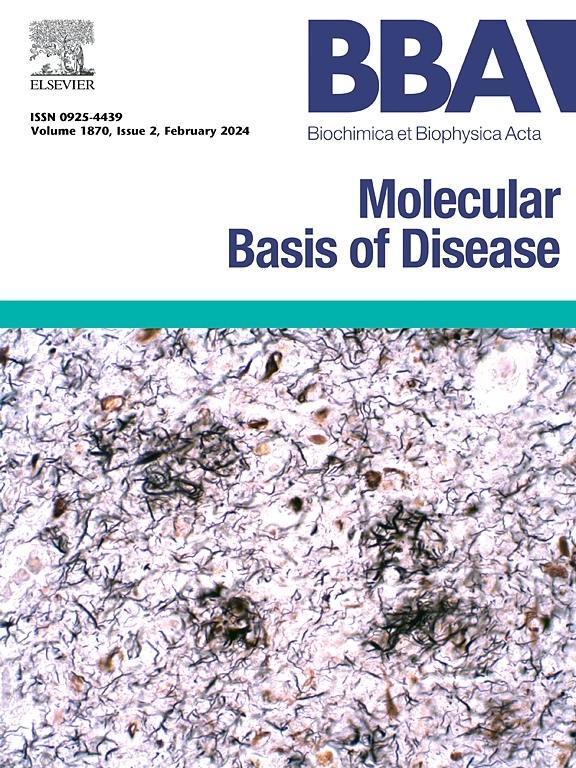ANXA1 facilitates myeloid-derived suppressor cell infiltration in the non-small cell lung cancer immunomicroenvironment via the STING/NF-κB/CXCL5/CXCR2 signaling axis to enhance tumor progression
IF 4.2
2区 生物学
Q2 BIOCHEMISTRY & MOLECULAR BIOLOGY
Biochimica et biophysica acta. Molecular basis of disease
Pub Date : 2025-07-03
DOI:10.1016/j.bbadis.2025.167965
引用次数: 0
Abstract
The infiltration of immune cells within the tumor microenvironment is a crucial determinant of the therapeutic efficacy of cancer immunotherapy. In non-small cell lung cancer (NSCLC), elucidating the regulatory mechanisms that govern the immune microenvironment is of substantial clinical importance. This study identifies Annexin A1 (ANXA1) as a key mediator in promoting the establishment of an immunosuppressive microenvironment driven by tumor cells. Clinical findings demonstrate that increased ANXA1 expression in NSCLC is highly correlated with worse prognosis and reduced effectiveness of immunotherapy. Complementary in vivo experiments further demonstrate that ANXA1 facilitates subcutaneous tumor progression and enhances the recruitment of myeloid-derived suppressor cells (MDSCs), thus fostering an immunosuppressive tumor microenvironment. Mechanistically, ANXA1 modulates the methylation status of UHRF1 (Ubiquitin-like plant homeodomain and RING finger domain-containing protein 1), disrupting DNA damage repair processes and leading to the accumulation of cytosolic double-stranded DNA (dsDNA), which triggers the activation of the STING/NF-κB/CXCL5 signaling axis. CXCL5 binds to its receptor CXCR2 on MDSCs, thereby promoting their recruitment. Importantly, inhibition of CXCR2 effectively reverses ANXA1-mediated MDSCs infiltration. These results elucidate the essential function of ANXA1 in modulating the recruitment of MDSCs within the immune environment of NSCLC, establishing ANXA1 as a significant therapeutic target for the advancement of innovative immunotherapeutic approaches.
ANXA1通过STING/NF-κB/CXCL5/CXCR2信号轴促进非小细胞肺癌免疫微环境中髓源性抑制细胞浸润,促进肿瘤进展。
肿瘤微环境中免疫细胞的浸润是肿瘤免疫治疗效果的关键决定因素。在非小细胞肺癌(NSCLC)中,阐明控制免疫微环境的调节机制具有重要的临床意义。本研究确定了膜联蛋白A1 (ANXA1)是促进肿瘤细胞驱动的免疫抑制微环境建立的关键介质。临床研究表明,在NSCLC中,ANXA1表达升高与预后不良和免疫治疗效果降低高度相关。补充的体内实验进一步证明,ANXA1促进皮下肿瘤的进展,增强髓源性抑制细胞(MDSCs)的募集,从而形成免疫抑制的肿瘤微环境。机制上,ANXA1调节UHRF1(泛素样植物同源结构域和含环指结构域蛋白1)的甲基化状态,破坏DNA损伤修复过程,导致胞质双链DNA (dsDNA)的积累,从而触发STING/NF-κB/CXCL5信号轴的激活。CXCL5在MDSCs上与其受体CXCR2结合,从而促进其募集。重要的是,抑制CXCR2可有效逆转anxa1介导的MDSCs浸润。这些结果阐明了ANXA1在调节NSCLC免疫环境中MDSCs募集中的重要功能,确立了ANXA1作为创新免疫治疗方法的重要治疗靶点。
本文章由计算机程序翻译,如有差异,请以英文原文为准。
求助全文
约1分钟内获得全文
求助全文
来源期刊
CiteScore
12.30
自引率
0.00%
发文量
218
审稿时长
32 days
期刊介绍:
BBA Molecular Basis of Disease addresses the biochemistry and molecular genetics of disease processes and models of human disease. This journal covers aspects of aging, cancer, metabolic-, neurological-, and immunological-based disease. Manuscripts focused on using animal models to elucidate biochemical and mechanistic insight in each of these conditions, are particularly encouraged. Manuscripts should emphasize the underlying mechanisms of disease pathways and provide novel contributions to the understanding and/or treatment of these disorders. Highly descriptive and method development submissions may be declined without full review. The submission of uninvited reviews to BBA - Molecular Basis of Disease is strongly discouraged, and any such uninvited review should be accompanied by a coverletter outlining the compelling reasons why the review should be considered.

 求助内容:
求助内容: 应助结果提醒方式:
应助结果提醒方式:


